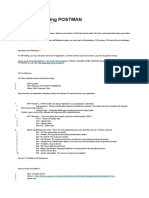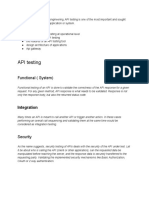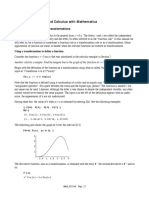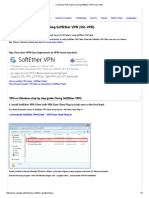API Testing Tool with Pros
and Cons
API: - Application programming interfaces (APIs) allow
software programs to communicate with each other by
sending and receiving API calls, or requests for
information.
API Testing: - API testing is a type of software testing
that focuses on verifying and validating APIs
(Application Programming Interfaces) to ensure their
functionality. It is a critical part of the software
development lifecycle, especially as applications
become increasingly reliant on APIs to communicate
between different components or services.
Here's a detailed overview of API testing: -
Key Objectives of API Testing: -
1.Functionality Testing: - Verify that the API
functions meet the expected specific requirements
and ensure that all outputs are correct response
based on the input.
2. Performance Testing: - Test the API’s
response time and stability under various
conditions. And evaluate the API behaviour under
stress and its ability of handling concurrent
requests.
3.Security Testing: - Check for vulnerabilities
such as authentication issues, data exposure, and
lack of encryption. And ensure that the API can
only be accessed by authorized users and that
sensitive data is protected.
4. Reliability Testing: - Verify that the API
consistently performs well over time, including
handling various types of requests and error
conditions. Also test API's uptime and response
consistency.
5. Integration Testing: - Validate how the API
integrates with other services and systems. Ensure
that data is correctly passed between different
components that rely on the API.
Types of API Testing: -
1. Functional Testing: - Focuses on testing the
API's functionality against the specified
requirements. Tests include verifying endpoints,
request methods (GET, POST, PUT, DELETE), and
expected responses.
2. Load Testing: - Assesses how the API
behaves under expected and unexpected load
conditions. Tests include sending multiple requests
simultaneously to evaluate performance.
3. Security Testing: - Involves checking for
security vulnerabilities such as SQL injection, cross-
site scripting (XSS), and proper authentication
mechanisms.
4. Error Handling Testing: - Tests how the
API handles invalid requests or unexpected input.
Verifies that appropriate error codes and messages
are returned.
5. Documentation Testing: - Ensures that
API documentation accurately reflects the actual
behaviour of the API and that all endpoints,
parameters, and responses are documented.
API Testing Tools: - Several tools can be used for
API testing, including:
Postman: - Postman is a powerful tool used for
testing APIs. It provides a user-friendly interface for
developers and testers to create, test, and automate
HTTP requests, making it easier to work with APIs
without needing to write code or scripts from scratch.
Key Concepts of Postman: -
1. API (Application Programming Interface):
- An API is a set of rules that allows different
software applications to communicate with each
other. It defines how requests and responses should
be structured.
2. HTTP Methods: - Postman supports various
HTTP methods, each used for different types of
operations:
GET: Retrieve data from the server.
POST: Send data to the server, often to create a
new resource.
PUT: Update an existing resource on the server.
DELETE: Remove a resource from the server
Pros: -
1. Making API Requests: - Postman allows users to
create and send HTTP requests to test and interact
with APIs.
2. Collections: - Collections are groups of requests
that can be saved and organized together. This
helps in managing multiple API endpoints for a
project in one place.
3. Environment Variables: - Postman allows you to
set environment variables for values like URLs, API
keys, or tokens. This is useful when you work with
different environments (development, staging,
production) and want to reuse the same request
across those environments.
4. Authorization: - APIs often require authentication.
Postman supports different types of
authentications, such as:
Basic Auth: Simple authentication using a
username and password.
Bearer Token: Typically used with OAuth to
authorize requests using a token.
API Key: Send an API key to identify the
requesting client.
OAuth: For secure authorization.
5. Headers: - Headers are additional pieces of
information sent with API requests.
Content-Type: Specifies the type of data being
sent, such as application/json.
Authorization: Used to authenticate API requests.
6. Body: - For methods like POST and PUT, where you
need to send data, Postman allows you to define
the body of the request.
7. Testing and Automation: - Postman provides a
way to write tests in JavaScript that run after your
request is sent. You can check for status codes,
validate response data, or even chain requests
together.
8. Response Visualization: - When you send a
request, Postman shows the response returned by
the server. It can display the data in different
formats like JSON, XML, HTML, or text.
9. Mock Servers: - Postman allows you to create
mock servers to simulate API responses. This is
helpful for testing front-end applications when the
back-end APIs are not yet built.
10. API Documentation: - Postman can
automatically generate documentation for your API
from the requests you’ve created. This is helpful
for sharing your API with other developers or
stakeholders.
Cons: -
Performance issues with large projects: As the
number of collections grows, Postman can
become slower.
Limited automation: For large-scale automation,
you may need to integrate it with CI/CD tools.
Heavy on memory: It can consume a lot of
resources, especially when working with large
requests or collections.
How to Use Postman: -
Create a New Request: - In Postman, you can
create a new request by selecting the method (GET,
POST, PUT, etc.), adding the URL, setting up
authorization and headers, and sending the request.
Check the Response: - Postman will display the
server's response, including the status code and the
body, if available. You can check whether the API
returned the expected data.
Save Requests and Organize in Collections: -
You can save individual requests to collections to keep
your workspace organized. Collections are useful for
grouping related API endpoints.
Use Environment Variables: - You can define
variables for commonly used values like base URLs or
tokens. This allows you to easily switch between
environments without manually editing the requests.
Write Tests: - Add JavaScript-based tests in Postman
to verify that your API works as expected. This is useful
for automated testing and validation.
Mock APIs and Generate Documentation: -
Use mock servers to simulate API responses, and
generate API documentation directly from Postman.
Why Use Postman?
User-Friendly: Postman provides a simple, intuitive
interface for working with APIs.
Supports All HTTP Methods: Easily make GET,
POST, PUT, DELETE, PATCH, and other requests.
Collaboration: Postman makes it easy to share
requests, collections, and environments with
teammates.
Automation and Testing: Postman is great for
writing and automating API tests.
Comprehensive Tool: With Postman, you can do
everything from designing and mocking APIs to
generating documentation and running automated
tests.
Conclusion: -
Postman is an indispensable tool for anyone working
with APIs, providing an easy-to-use platform for testing,
developing, and automating API requests. Whether
you're a back-end developer, front-end developer, or
QA engineer, Postman can simplify the process of
interacting with APIs and help streamline your workflow.























































































